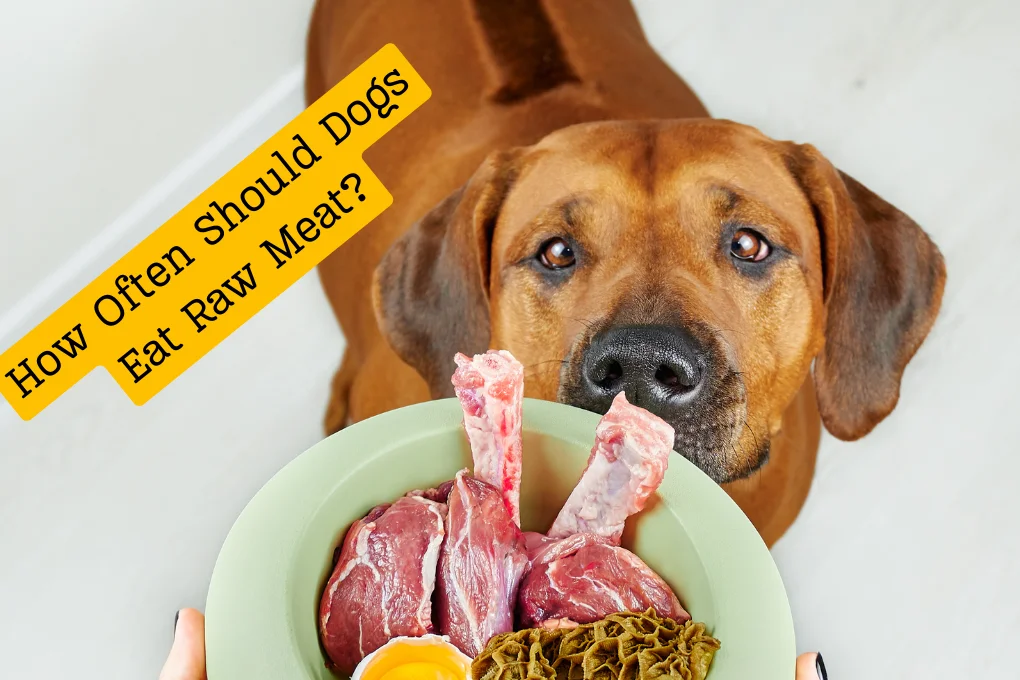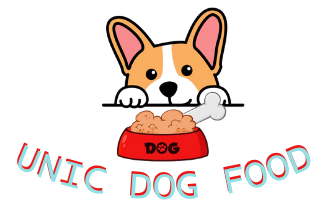In recent, raw meat diets have been gaining traction among dog owners. But how often should dogs eat raw meat?
Raw meat diets for dogs, often known as BARF (Biologically Appropriate Raw Food) or PMR (Prey Model Raw), have gained popularity among pet owners seeking a more natural feeding regime for their furry companions.
Such diets are based on the principle that dogs, as descendants of wolves, are naturally inclined to consume raw meat.
This article discusses the frequency of raw meat consumption for dogs, its nutritional requirements, advantages, and disadvantages.
Can Dogs Eat Raw Meat?
Yes, dogs can eat raw meat. It is generally not recommended to feed dogs raw meat. Raw meat can contain harmful bacteria and parasites that can cause health problems for dogs.
Additionally, raw meat can be difficult for dogs to digest, leading to nutritional deficiencies.
If you choose to feed your dog raw meat, it is important to do so safely and hygienically.
If you’re considering a raw meat diet for your dog, I recommend consulting with a veterinarian or canine nutritionist first.
They can guide you on the right raw meat proportions and types for your dog’s specific needs.
How Often Should Dogs Eat Raw Meat?
The consensus is that the frequency of feeding raw meat to dogs can vary based on several factors, including age, activity level, and specific health needs.
It's generally fine for adult dogs to feed them raw meat once or twice a day. This frequency can support their energy needs and digestion.
In the case of active working dogs or canine athletes, some owners prefer feeding them twice daily as it’s believed to aid recovery and provide constant fuel for their system.
However, others feel that feeding them once per day might optimize their performance, especially if the meal is given after their day’s activities.

It’s thought that dogs perform better with an empty stomach during exercise due to optimized fat-burning enzymes and endurance.
Ultimately, the choice of feeding frequency should be based on what works best for your dog, considering their metabolism, energy requirements, and the duration of their exercise.
Puppies, on the other hand, have different needs. They are growing rapidly but have small stomachs, so it’s recommended that puppies under 3 months old eat at least 3 times a day.
As they grow, you can reduce this to twice a day until they are fully mature; at this point, you can switch to once a day if you prefer.
Considerations for a Raw Meat Diet
◉ Safety and Quality: It’s crucial to use high-quality meat and ensure it’s free from harmful bacteria like Salmonella and E. coli.
Some services offer pre-portioned patties with balanced proportions of muscle meat, organ meat, and bone, meeting nutritional standards.
◉ Balanced Nutrition: Properly balancing meat, organs, and bones is essential. The recommended proportions are about 80% muscle meat, 10% bone, and 10% organ meat.
◉ Consulting a Vet: Always consult your veterinarian before switching to a raw diet, especially for puppies, seniors, and those with specific health issues.
Potential Benefits and Risks
◆ Benefits: Proponents of raw diets cite benefits like shinier coats, healthier skin, better digestion, and more energy.
◆ Risks: However, there are risks like bacterial contamination, nutritional imbalances, and potential choking hazards or broken teeth from bones.
Personal Routine and Dog’s Health
Monitor your dog’s health closely when on a raw diet, including their weight, coat, and overall well-being. Adjust their diet as needed.
The feeding schedule can be flexible and adjusted according to your routine and dog’s needs. Just remember to feed them at consistent times each day for regularity.
Transitioning to Raw Meat Diet
When transitioning your dog to a raw diet, gradually avoid digestive issues like diarrhea. Mix raw meat with their current food and gradually increase the raw portion.
Feeding your dog raw meat is a commitment that involves understanding your dog’s specific needs and ensuring their diet is safe and nutritionally balanced.
Always consult a veterinarian for personalized advice tailored to your dog’s health and lifestyle.
Will Raw Meat Hurt My Dog?
Raw meat, in general, won’t hurt your dog if it’s handled correctly and is part of a balanced diet. Thanks to their short digestive tracts and strong stomach acids, dogs can digest raw meat.
However, there are risks like bacterial infections and nutrient imbalances if the raw meat is not fresh or properly prepared.
It’s also important to ensure the raw meat diet includes a balanced mix of meat, organs, and bones for complete nutrition.
I always recommend consulting with a vet or a canine nutritionist to ensure the raw diet meets your dog’s specific nutritional needs and learn about safe handling and preparation practices.
Remember, each dog is different, so what works for one might not be ideal for another.
Can dogs eat raw meat everyday?
Yes, dogs can eat raw meat everyday as it is a natural and healthy diet. All the nutrients dogs require, including protein, fat, vitamins, and minerals, are in raw meat.
It is also a good source of moisture to maintain dogs’ hydration. Feeding dogs raw meat carries some risks, including the potential for parasite or bacterial contamination.
To minimize these risks, choosing high-quality meat from a reputable source and following safe handling and storage practices is important.
Additionally, some dogs may have difficulty digesting raw meat, so it is important to introduce it slowly and monitor your dog’s reaction.
How much raw meat should I feed my dog daily?
The amount of raw meat you feed your dog daily depends on several factors, including size, activity level, and age.
A general rule of thumb is to feed your dog 2-3% of their body weight in raw meat per day. This means a 50-pound dog would need to eat 1-1.5 pounds of raw meat daily.
However, it is important to note that this is just a general guideline. The amount of raw meat you need to feed your dog may vary depending on their needs.
Here are some guidelines to help you:
Adult Dogs
For adult dogs, the amount of raw food to feed typically ranges from 2% to 3% of their ideal body weight.
This percentage can vary depending on your dog’s activity level, metabolism, and whether they need to lose, maintain, or gain weight.
For instance, an active adult dog might need 3% of their ideal body weight, while a less active or overweight dog might only need 2%.
Puppies
Puppies have different requirements as they are growing. The amount they need to eat can range from 8% to 10% of their body weight when they are very young (7-10 weeks old), decreasing gradually to about 2% to 3% as they approach adulthood (after 68 weeks).
Puppies are fed more frequently, typically three to four small meals daily.
Small Dogs
For smaller dogs, you might need to feed a higher percentage of their body weight compared to larger dogs.
For example, dogs up to 5 lbs might require 5-6% of their ideal adult weight per day, while those between 6 and 10 lbs might need 4-5%.
Senior Dogs
Older dogs, especially those less active or overweight, may require less food, typically around 1.5% of their ideal adult weight per day.
Here are some additional tips for feeding your dog a raw meat diet:
* Make sure the meat is fresh and of high quality.
* Feed your dog a variety of meats, including muscle meat, organ meat, and bones.
* Do not feed your dog raw pork or poultry; these meats can carry harmful bacteria.
* Feed your dog raw meat only if they are healthy and have a strong immune system.
* Monitor your dog for signs of illness, such as vomiting, diarrhea, or weight loss.
* If you have any concerns about feeding your dog a raw meat diet, consult a veterinarian or canine nutritionist.
FAQs
Is raw meat safe for all dogs?
While many dogs thrive on a raw meat diet, it’s unsuitable for all. Dogs with certain health conditions or weakened immune systems may require a different diet.
Can puppies be fed a raw meat diet?
Puppies can eat raw meat, but their diet needs to be carefully balanced to ensure they receive all the necessary nutrients for growth.
What are the main benefits of feeding dogs raw meat?
Benefits include improved dental health, shinier coats, higher energy levels, and better digestive health.
Are there any risks associated with raw meat diets for dogs?
Potential risks include bacterial contamination, nutritional imbalances, and choking on bones.
How can I transition my dog to a raw meat diet?
Transitioning should be gradual, starting with small amounts of raw meat mixed into their current diet and gradually increasing the raw content.
Conclusion
Giving your dog raw meat is possible, but you should exercise caution and seek professional advice before doing so.
Feeding your dog raw meat can be a rewarding and healthful experience with many advantages when done correctly.
It’s critical to conduct in-depth research, speak with a veterinarian, and customize the diet to meet your dog’s specific requirements.
Remember that every dog is different, so what suits one might not suit another.
- Homemade Bone Broth For Dog Recipe - December 17, 2025
- Can You Cook Raw Dog Food? - September 10, 2025
- Homemade No-Bake Dog Treat Recipes Your Pup Will Love - September 6, 2025
